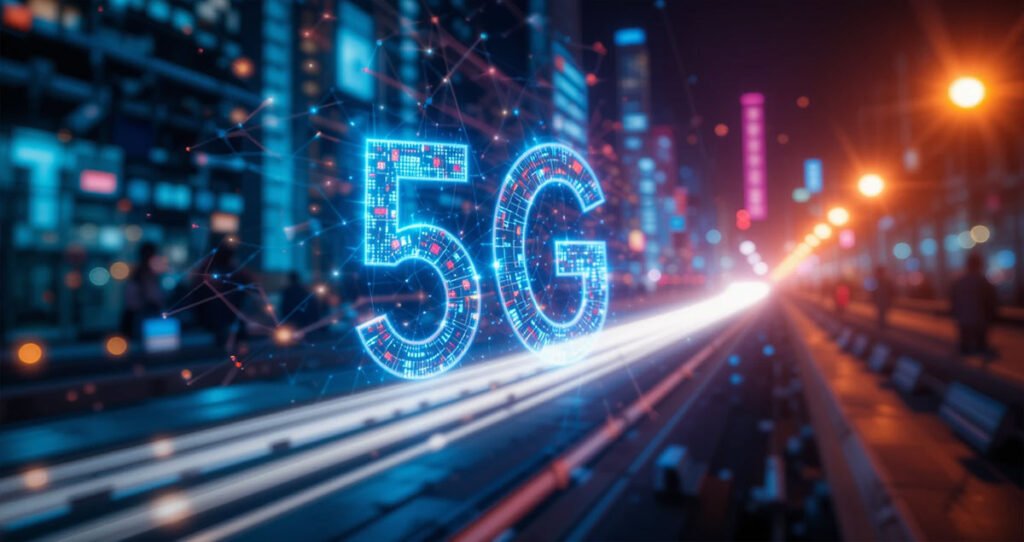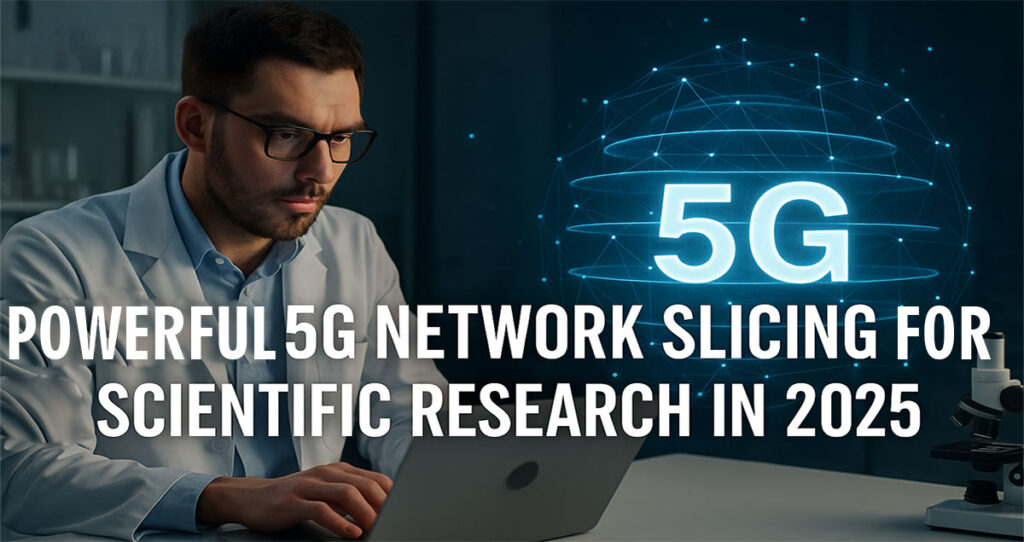In 2025, 5G network slicing is changing the way science is researched by supplying ultra-reliable, low-latency security networks designed for different research purposes. By using this technology, there is quick data processing, convenient teamwork from afar, and easy use of resources, making experiments much better and helping innovation grow more rapidly in several fields.
The Next Frontier in Connectivity: Why 5G Matters Now More Than Ever
What Makes 5G Different from 4G and Previous Technologies
Improved internet speed is only a result of moving from 4G to 5G; the main change lies in how information is managed and distributed. As a consequence, 5G gives us fast responses, extra bandwidth, and allows many more devices to be connected at the same time. Millimeter-wave frequencies, massive MIMO, and beamforming are helping to boost measurement capabilities.

With these improvements, there is now real-time communication, which is necessary for use in autonomous vehicles, remote surgeries, and scientific simulations that need results quickly. Through the use of 5G, scientists can bring together many types of data, improving their analysis process.
The Explosion of Data in Scientific Research: A Demand for Speed and Stability
With the rise of modern research, we have never created as much data before. In genomics, climate science, and particle physics, large amounts of information, or terabytes, are produced every day. The big data we create exceeds the capacity of traditional networks, which leads to slow processing and delayed discoveries.
5G fixes this by providing a stable and quick connection for handling significant data. Network slicing helps create special networks for different types of data and makes sure important research data is delivered unhindered. A system that offers such customization and reliability is vital for any research project where time is important.
The Rise of Real-Time Applications and Smart Research Infrastructure
Experiments now happen differently, and data analysis is different as a result of using real-time applications in research. Because IoT sensors, AI reverse, and remote lab tools must transmit data instantly, 5G’s low latency makes this possible.
Because environmental monitoring needs rapid information, this feature is most useful in that field. In addition, the large capacity of 5G for supporting many devices supports the establishment of smart research infrastructures, where research equipment and tools work together more smoothly and efficiently.
What is 5G Network Slicing? A Complete Breakdown
Simple Explanation: Think of Network Slices as Private Internet Highways
Picture the internet as a huge and organized system of roads. Because cars, trucks, and bikes all use the same roads in a traditional network, congestion and delays are the result. By applying 5G network slicing, dedicated pathways for different traffic can be created. Every “slice” offers a personalized network meeting with needs for speed, response time, and protection.
A single slice of cloud computing could handle fast transfers of genomic information, while another slice could be set up to support remote surgeries that require very little delay. Because the workload is separated in this way, no other applications disturb an application as it operates, a bit like useful lanes on a highway for particular vehicles.
Technical Dive: Virtualization, QoS, and Isolated Resources
5G network slicing is mainly powered by virtualization and Quality of Service (QoS) technologies. With virtualization, you can make several different virtual networks run on top of one physical system, each operating without interacting with the other. This happens through SDN and NFV, which break apart network functions from the underlying hardware so that networks can be configured and managed flexibly.
As a result of QoS management, each slice is designed to fulfill key performance requirements like bandwidth, latency, and dependability. Segmenting resources allows different problems in each slice not to affect the others, so all applications perform reliably. This is most important in scientific studies, since keeping data accurate and processed quickly is essential.
Use Cases Beyond Science: Gaming, Healthcare, Smart Cities
Scientific research benefits a lot from 5G network slicing, although it’s used in other industries as well. Having dedicated slices in games ensures that users can enjoy both low reaction times and steady bandwidth. Telemedicine and surgeries performed over long distances can be supported by network slicing, since a stable and safe connection is key in healthcare.
Different needs for traffic, security, and utility services in smart cities are met by assigning each slice to a relevant network system. Thanks to network slicing, 5G is enabling unique network solutions that encourage innovation and productivity in many different industries, pointing to its major impact beyond science.
The Scientific Community’s Network Crisis
Why Traditional Networks Can’t Keep Up with Modern Science
It was not initially intended for traditional networks to support the intensive use of data in today’s scientific studies. They don’t always have the flexibility, quick response, and reliability required to handle live data and teamwork. With higher numbers of disciplines cooperating in research and large datasets being processed, it is now clear that existing networks are reaching their limits.

When network congestion causes there to be too many users at the same time, latency causes delays and insufficient bandwidth, which all slow the data moving across the network, analysis, and teamwork between researchers. That’s why it’s important to have advanced networking like 5G network slicing, which is needed for creating the right type of wireless connections scientists require.
How Bandwidth Bottlenecks Cripple AI, Genomics, and Cloud Experiments
The use of data processing and transmission heavily relies on having sufficient bandwidth, and in many industries, this turns out to be a major difficulty. For AI research to work well, data needs to be transferred fast from storage to the processing part of the system. Because genomic studies rely on large sets of genetic data, the process requires rapid transfer of information for the analysis and interpretation.
Apply-cloud experiments require a strong connection to access computing resources and cooperate with teams from distant locations. Having a limited amount of bandwidth in traditional networks can cause problems such as delays, data loss, and slower research progress. The solution is found in a 5G network that segregates bandwidth, providing the specific connections researchers require.
The Real Cost of Network Downtime in High-Stakes Research
When networks are down in critical research settings, the results can be very damaging. When experiments must be completed quickly, delays in data transfer can result in errors or the requirement to run the procedures again. When multiple organizations work together on data, interruptions can slow down the project and tax the partnerships.
Besides, network issues in healthcare and environmental monitoring might block important choices, which could even risk the health and lives of people. Because network disturbances are so costly for a business, it is crucial to rely on strong and reliable solutions. Using network slicing through 5G is effective for research groups since it reduces the risks of interruptions and keeps activities going without disruptions.
5G Slicing to the Rescue: How It Solves Key Scientific Problems
Dedicated Resources for Uninterrupted Research Data Flow
5G network slicing provides dedicated virtual networks that ensure uninterrupted data flow for research activities. Specifically managing resources for each network stops the problems of overcrowding and unpredictable timing typically found in shared networks. Because of this approach, the system can support transferring large data sets and enable real-time communication among research teams. Since ongoing monitoring of the data is necessary in many experiments, any gap can endanger the results.
Real-Time Remote Collaboration & Edge Computing for Field Experiments
Working together online with people from different countries is now required, not just helpful. More and more, scientists from different parts of the world work cooperatively on hard research. Even so, standard network systems have a hard time providing the speed and reliability necessary for instant work collaboration. 5G network slicing is truly valuable in this situation. Because of its unfailing, low-delay performance, scientists can quickly get real-time data from any field device, sensor, or lab directly to analysis centers.
An even bigger advantage comes from attaching edge computing to the 5G framework. Working on data at the source, rather than at the main server, both cut down delays and reduce the burden on the main databases. If micro data centers are used in concert with 5G slicing, insights can be generated on the spot and sent directly to scientists. Think of scientists in the Arctic and at sea working with fast and uninterrupted high-definition video streaming to their groups.
For this reason, explorations, judgment calls, and synchronization are done faster and more efficiently in the toughest environments.
Ultra-Reliable Low Latency Communication (URLLC) in Precision Science
In situations where speed matters most, Ultra-Reliable Low Latency Communication (URLLC) is very important. The purpose behind this subset of 5G is to meet the very low latency and dependability requirements of mission-critical applications. URLLC makes a major difference in scientific research. It yields the use of robots in operating rooms, online labs, science carried out without human guidance, and crisis routines for biohazardous events.
Let’s think about space exploration. People working with data from satellites or controlling rovers on other planets must act quickly and accurately at any moment. 5G slicing with URLLC ensures that commands and data transmissions occur without delay or error. Similarly, in molecular biology, automated lab systems use URLLC slices to carry out high-speed reactions with exact precision.
In fields where a fraction of a second can mean the difference between success and failure, URLLC embedded within network slices delivers unwavering performance. It’s this blend of speed and reliability that’s propelling science into a bold new era of hyper-precision.
Real-World Case Studies of 5G Network Slicing in Research
Nothing illustrates the impact of 5G network slicing better than seeing it in action. Across the globe, pioneering institutions and research centers are integrating this technology into their workstreams, transforming not only how they operate but also what they can achieve.
- Remote Surgery & Biotechnology Labs: A university hospital in Sweden successfully conducted a real-time robotic surgery using a 5G slice, demonstrating how remote medical procedures can be life-saving and accessible globally.
- Climate Simulation Centers: In Germany, climate researchers are utilizing dedicated 5G slices to simulate environmental changes with edge computing nodes located in rural regions, reducing delay and improving predictive accuracy.
- Astronomy & Space Agencies: NASA-affiliated observatories use 5G slices to stream high-definition video from telescopes and satellites. These slices guarantee ultra-stable data transfer for astronomers collaborating across continents.
Each of these case studies showcases how network slicing not only boosts efficiency but also breaks the barriers of distance, time, and reliability that once hindered scientific progress.
Remote Surgery and Bio-Tech Labs Using 5G Slices
Because precision in medicine can be crucial, 5G slicing enables important changes in the field. Practitioners use 5G slices in biotech labs and hospitals to speed up health assessments, conduct operations at a distance, and protect private health information.
A network slice can be prepared to provide fast operation and a high level of reliability, which lets surgical robots perform smoothly at any distance from a surgeon. These dedicated slices are isolated from general internet traffic, which reduces lag and ensures secure, uninterrupted performance.
Additionally, biotech companies are conducting high-throughput sequencing with the help of cloud-based tools that rely on these high-performance slices. As a result, research related to gene therapy, personalized medicine, and pandemic response is completed more quickly. In light of everything, 5G network slicing isn’t just about upgrading; it’s vital for survival.
Climate Simulation Centers with Autonomous Data Pipelines
One of the most powerful applications of 5G network slicing lies in climate science. Researchers in this field require immense computational power and real-time data collection from satellites, remote sensors, and monitoring stations located in extreme and often inaccessible areas.

By working with 5G network slices and autonomous data pipelines, climate simulation centers obtain and analyze current environmental data automatically. For instance, an area on the network can be assigned lots of bandwidth so sensor readings from Greenland can be routed smoothly to a storage center in Zurich. These systems process data using AI, tidy it, sort it, and make models that climate scientists can make forecasts more accurately and swiftly.
Moreover, having network slices ensures that even during public emergencies or natural disasters, the communication lines for climate monitoring stay open and stable. This contributes to better preparedness and quicker, more informed responses to environmental threats.
Space Agencies and Astronomical Data Streaming on Isolated 5G Channels
Observations in space and pictures of planets from deep space create large and often surprising amounts of data. Space agencies need a system for communication that offers high bandwidth, little latency, and certainty that it will not fail over great distances. In such tasks, separated, high-priority channels, possible with 5G network slicing, come in handy.
A 5G slice created for telescope arrays to send petabytes of data to research centers keeps the signal steady and avoids interruptions. Whether it’s streaming solar flares from satellites or processing cosmic radiation data from deep space, network slicing helps maintain continuous and interference-free data flow.
In addition, real-time control of space equipment like rovers, drones, or telescopes from Earth is now more feasible thanks to URLLC slices. These applications rely on very quick and reliable data transmission at all times. 5G allows these agencies to watch, direct, and recover data safely, even when Wi-Fi or cell service is weak or unavailable.
Security, Scalability, and Customization: The Triple Advantage of 5G Slices
Three principal issues must be addressed in scientific research: protecting the data, scaling the network as needed, and configuring performance according to specifications. Traditional networks are structured the same for all users and aren’t enough for scientists today. 5G network slicing changes that.
Because of full encryption and separate pathways, each slice is secure and cannot be harmed by the others. It is vital for places handling confidential information from genes or research sponsored by the government.
Scalability allows organizations to scale bandwidth and performance based on active projects. A biology lab running intense simulations can temporarily increase its slice’s resources, then scale down when demand drops—saving costs and resources.
Customization gives institutions granular control over performance metrics like latency, throughput, and data routing. Whether it’s configuring slices for AR-enhanced lab equipment or AI-driven analytics, 5G slices deliver tailor-made connectivity.
These triple benefits are what truly separate 5G slicing from any network model that came before.
End-to-End Encryption and Isolated Environments for Data Privacy
Privacy is paramount in research, particularly when dealing with patient health records, pharmaceutical formulas, or intellectual property. With 5G network slicing, each virtual slice can be isolated with its end-to-end encryption, ensuring total data protection.
These encrypted slices are structured in such a way that they don’t interact with the rest of the network, eliminating cross-contamination of data. This setup is invaluable for joint projects across international boundaries where data jurisdiction laws are complex and security protocols must be airtight.
Research institutions can use 5G encryption and separate areas on the network to do cloud trials, exchange data worldwide, and keep sensitive datasets safe from hacks or data loss. As a result, businesses can follow multiple laws, such as HIPAA, GDPR, and other regulations, more easily.
In the context of this model, security isn’t optional but is core to all 5G slice-based digital interactions.
Flexible Network Sizing According to Research Needs
Scientific research isn’t static. Needs fluctuate based on the size and intensity of the project, which is why network flexibility is non-negotiable. 5G network slicing delivers just that—on-demand, adjustable bandwidth and speed that scales with your project.
For example, a university conducting nationwide soil studies may need to scale up a network slice to handle hundreds of remote IoT sensors collecting data in real time. Once the study concludes, that slice can be scaled back, freeing up resources and reducing costs.
This dynamic allocation model means no more overpaying for unused capacity or underperforming when traffic spikes. It allows institutions to match their network capacity with real-time research demand, streamlining resource management and ensuring high performance, 24/7.
The result? Faster discoveries, smoother operations, and smarter spending—all enabled by network flexibility that traditional models can’t compete with.
AI-Based Slice Orchestration: Customization on the Fly
One of the most exciting features of modern 5G slicing is its compatibility with AI-driven orchestration systems. These intelligent tools can dynamically manage and optimize each network slice, tailoring performance metrics in real-time based on workload requirements.
Let’s say a research center is conducting simultaneous DNA sequencing and virtual simulations. Based on urgency and data needs, an AI orchestrator can move resources among the slices by itself.
Having adaptability makes it possible to fix problems in real time. If a remote sensor does not work, the AI system can quickly reorganize traffic or distribute resources so that data doesn’t get interrupted. It provides predictions, allowing it to detect when congestion or trouble points are coming and to respond accordingly.
With AI-driven orchestration, networks shift from being fixed to being flexible and responsive, just what today’s scientific studies require. It’s the perfect blend of intelligence and performance, and it’s available right now through 5G slicing.
Building a Smart Lab: Integrating 5G with IoT and AI
Traditionally fixed laboratories are now turning into active and smart places thanks to IoT and AI. When 5G network slicing is part of their work, these labs gain greater capacity to allow scientists to develop intelligent ecosystems that can regulate themselves.

Everything from how hot or cold it is and the quantity of chemicals used to working equipment can be tracked by IoT sensors. Real-time communication, low latency, and less interference are the advantages these devices get when they use their own 5G slice. It guarantees correct, immediate responses and reduces the chance of delays or issues with the data.
By using AI, these labs are able to review data from sensors as it enters. AI algorithms flag anomalies, predict failures, and optimize experimental settings—all while learning and adapting in real-time. 5G slices make it possible to run these complex processes simultaneously without compromising performance.
With this powerful trio—5G, IoT, and AI—scientific institutions are entering a new era of autonomy, efficiency, and precision in research.
Machine Learning Pipelines That Depend on Network Precision
ML is now an important tool for transforming scientific research with the help of data. Still, in order for ML to succeed, it requires continuous contact with huge datasets and fast processing. So, 5G slicing is crucial at this stage.
Typically, research centers operating ML pipelines, primarily in areas such as drug discovery, climate simulation, and genetics, encounter huge amounts of unstructured data. A single delay in data flow can interrupt training models or compromise accuracy.
Ensuring low response time, high data speed, and rock-solid reliability, slices in 5G networks give institutions a network all for ML processes. Improved network precision allows Franco Ranch Academy researchers to quickly develop precise models, process information smoothly, and unite with others in real-time collaboration regardless of their locations.
All in all, 5G-enabled network slicing allows machine learning to function smoothly, on a large scale, and with the reliability needed for today’s demanding applications.
Automation, Robotics, and Augmented Reality in 5G-Enabled Labs
Automation isn’t gone; it’s here already, and 5G slicing is making it possible. In many advanced laboratories, robots execute accurate tests, and augmented reality (AR) teaches staff how to carry out tricky processes. All of these systems depend on quick, steady data being moved around.
By deploying these tools on isolated 5G slices, labs gain uninterrupted, real-time performance, even under heavy loads. Robotic arms conducting microfluidic tests need ultra-reliable communication to perform flawlessly. Training and diagnostic tools using AR need video and data to move quickly and be responsive.
The virtual lanes made possible with 5G slicing ensure that the automation systems, AR devices, and robots are supported by the exact data services they require. With this, there are no delays or interruptions when many systems run at once.
5G allows machines and people in labs to team up smoothly, easily,, and with improvements over time. The result? Faster discoveries, higher accuracy, and safer experimental environments.
The Economics of 5G for Research Institutions
Cost concerns often surround 5G slicing and related modern technologies. Let’s discuss that now. Truly, 5G is one of the most economical ways for research institutions to stay connected because it is both flexible and can be scaled as needed.
Rather than spending a lot on fixed networking, institutions can start with virtualized 5G slices that change in size depending on their requirements. Since the elasticity helps adjust, you do not have to deal with problems from over- or underserving your users.
As well, 5G slicing helps avoid upgrading physical infrastructure. By using virtual slicing, you can handle the settings remotely, reducing the amount of around-the-clock maintenance and system downtimes. In other words, there will be more uptime, faster delivery, and fewer expenses.
Because of the results they see, universities, government labs, and private R&D firms agree that security improvements, more efficient work, and cost savings are justified. Because smart infrastructure is now more reasonably funded by available grants, 5G slicing is not a dream of the future but a need right now.
Government and Industry Investments in Scientific 5G Ecosystems
With the obvious benefits of 5G slicing for science, many countries and companies are now dedicating billions to developing infrastructure and carrying out research collaborations. A range of European and American programs provides financial support to ecosystems that depend on 5G for fast discovery in science.

The leading telecom firms are cooperating with universities and research centers to set up unique 5G laboratories. For example, South Korean and German tech hubs are currently running trials involving entire experiments relying on 5G slices.
These partnerships accelerate innovation, offering scientists access to the latest tech without waiting for broad national rollouts. And it’s not just about access—governments see 5G-powered science as a strategic investment. Given that emerging fields like AI, quantum computing, and synthetic biology now need a lot of data, 5G slicing is very important for keeping up with others globally.
The connection between policy, technology, and research money has become a perfect situation for 5G to power scientific achievements.
ROI and Long-Term Value of Slicing for Universities and Think Tanks
Many people wonder what the future payoff will be from investments in digital infrastructure. Universities and think tanks that implement 5G network slicing enjoy an edge in performance today and can compete better for years to come.
Many organizations find that usual wired and Wi-Fi networks need constant further development, extra equipment to add more connections, and a large staff to look after them. In addition, with 5G slicing, configurations can be made from anywhere, scaling is dynamic, and overall maintenance costs are lowered. These benefits translate to direct savings.
Moreover, institutions gain new opportunities to monetize their infrastructure, like renting out secure network slices to commercial research partners or startups. Hosting simulations, labs for shaping policies, and running joint international activities is possible for think tanks, as they do not need huge network changes.
Hosting simulations, labs for shaping policies, and running joint international activities is possible for think tanks, as they do not need huge network changes.
The Role of Telecom Providers in Supporting Scientific Innovation
Today, telecoms are teaming up with scientists rather than only focusing on phone connections. Teams made up of Verizon, Ericsson, Huawei, and Nokia are collaborating with universities to set up custom systems that help in data-driven research.
With these partnerships, scientists can benefit from network speed and quality unique to their research work. Through backend handling, orchestration, monitoring, and upgrades, telecom providers help researchers focus only on their research and experimentation.
There are examples where telecoms let universities use private 5G slicing on campus premises. These setups provide ultra-secure, high-performance environments for sensitive experiments. Such collaborations represent a new business model: Science-as-a-Service, backed by telecom technology.
With telecoms increasingly investing in 5G-enabled labs and R&D hubs, the future of network-based science looks collaborative, secure, and brilliantly optimized.
Private vs. Public Slicing Infrastructure: Which is Better for Science?
Not all slices are created equal. Scientific institutions often face a choice: invest in private slicing infrastructure or tap into publicly available slices offered by telecom operators. Each has its pros and cons.
Private slices give institutions full control over network configurations, security settings, and resource allocation. They work best for delicate studies that require the protection of intellectual property or follow regulations. Still, these systems are more expensive to purchase upfront and depend on people within the organization with specific knowledge.
Public slices, by comparison, are both cheaper and quicker to put into action. They’re maintained by telecom providers and are suitable for general-purpose research. But they may lack the granularity and customizability that some high-stakes research projects require.
The decision ultimately depends on an institution’s needs, budget, and long-term vision. Either way, both models are leaps ahead of the inflexible, one-size-fits-all legacy networks of the past.
Future Plans: 6G and Beyond for Scientific Exploration
While 5G is still unfolding, the race to 6G is already underway—and it’s poised to supercharge scientific research even further. 6G promises terahertz communication, quantum-level encryption, and real-time holographic transmissions. But what does this mean for researchers?
Imagine virtual labs in full 3D, real-time planetary data modeling, and AI-powered labs that run 24/7 with autonomous decision-making. 6G will make these scenarios feasible by building on the foundations that 5G slicing has laid down—hyper-personalized, high-speed, low-latency, and deeply integrated network environments.
Leading tech nations like China, South Korea, and the U.S. are already trialing pre-6G frameworks to have commercial implementations by 2030. For now, 5G slicing is the cornerstone of next-gen connectivity—but make no mistake: the future is already being written in terabytes.
Challenges in Deploying 5G Network Slicing at Scale
Even though 5G slicing is promising, getting it to work smoothly across many networks is not easy. Ensuring that older hardware can easily work with 5G technology is one of the biggest problems faced today. Upgrading sensors, routers, and endpoints can be costly for underfunded institutions.

Another barrier is spectrum allocation. Governments must coordinate spectrum availability for public and private slices without overlap or congestion. Failure to manage properly could result in reduced functionality and dangers to data.
It’s hard to find people with all the necessary skills, which shows that 5G slicing requires a combination of IT, telecom, and data science abilities. If teams are given insufficient training, diagnosing and handling different problems in their networks becomes a challenge.
These problems can be handled. By joining forces, preparing workers, and finding agreement on regulations, 5G slicing can move from limited use to being within reach of all researchers.
How Developing Countries Can Leverage 5G Slices for Research
5G network slicing is a terrific chance for developing countries to go beyond their old infrastructure and join the world of science. 5G solutions delivered through mobile networks let these countries cut down on the cost of building major data centers.
In rural areas, mobile science labs, using real-time sensors, AR technology, and satellite links, support research on agriculture, learning, and health. Because 5G slices are so affordable in these areas, universities can join global studies, use worldwide data, and submit their research for publication in leading journals.
One of the greatest benefits is that 5G provides science-friendly internet to everyone, so scientific progress is no longer missed in areas that couldn’t connect before. This move could help make the worldwide discussion in science much more varied and significant.
Conclusion: Unlocking the Future of Science with 5G Network Slicing
Final Thoughts on the Impact of 5G on Global Research Landscapes
In 2025, 5G network slicing will play a dominant role in shaping science. Today, scientists in all kinds of locations now depend on customized, secure, and fast virtual networks, leading to new improvements in pioneering science.
5G slicing goes beyond simple technology; it transforms the way things are done. It allows individuals to do research, grow innovation at a faster pace, and join forces in projects bringing together people from many places. Those who adopt open science move quicker and support the world in taking the next important step in learning.
FAQs About 5G Network Slicing for Scientific Research
What is network slicing in 5G, and what makes it work?
- With the help of 5G, you can divide a physical network into many virtual networks. For instances when you need only latency, high bandwidth, or high security, each layer is adjusted accordingly.
Can 5G slicing keep sensitive research data secure enough?
- Yes. All 5G slices are designed to be fully isolated and encrypted, so their data cannot be accessed or confused by other types of traffic.
Can limited research teams use 5G slices?
- Because it is now so accessible and due to stronger collaboration, even smaller educational places can start using cost-effective 5G tools through public ownership of connectivity.
The question is, is this 5G connection a public slice or is it a private slice?
- Telecom service providers take charge of public slices, which are for multiple users, but private slices are customizable just for one, making them good for experiments or high-level defense needs.
What differences will 5G make in how research and lab work are performed in the following decade?
- 5G will allow researchers to collaborate easily, use AI, and benefit from smart buildings; shorten research timeframes; allow more scientists to contribute; and encourage equality between nations.






Искал, как выбрать нормальных строителей — повсюду либо реклама, или страшилки. Пока не обнаружил на базу где собраны проверенные ресурсы, с живыми отзывами. Наконец-то понял, где искать нормальных специалистов
Каталог mydovidnikgospodarya.xyz